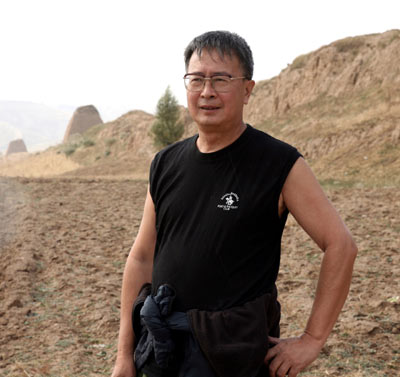Profiles
Great Wall enthusiast brings history into focus
By Cheng Yingqi (China Daily)
Updated: 2010-06-22 06:38
 |
Large Medium Small |
BEIJING - Using a book for guidance, two Taiwan people trekked 2,000 km looking for an old section of the Great Wall in a Beijing suburb. What they found instead proved to be an even greater discovery - Li Shaowen, the author of the book.
 Li Shaowen, the author of Tuwen Changcheng (A Description and Pictures of the Great Wall), stands in front of a dilapidated section of the Great Wall in this fi le photo. He wrote the book to share his enthusiasm for China’ s cultural heritage and to raise public awareness about the need to protect the Great Wall after two decades of visiting and photographing the wonder. [Provided to China Daily] |
Li, a 62-year-old retired professor, has spent more than two decades visiting and photographing the Great Wall across China. From his travels, he has written a series of books called Tuwen Changcheng or A Description and Pictures of the Great Wall.
When the Taiwan trekkers ran into Li , he was in his photographer's vest, holding half a beer and chatting with locals.
Relating the incident, Li said: "When I heard that my book led people here, I felt fulfilled, but that is not enough. The Great Wall needs more attention and better protection, because of its unique historic and cultural value."
"That is why I tell the story of the Great Wall," he said, adding that many problems highlighted in previous volumes of his tome attracted the government's attention.
According to Li, huge sections of the Great Wall have been destroyed over the years in wars, as a result of natural disasters and due to a lack of maintenance. Only few sections of what remains are under government protection.
"I once saw villagers using jade tablets with a Chinese dragon totem on them to build the wall of a pigsty. The tablets were part of a Great Wall nearby," Li said.
"I wrote about it in my book. When I visited that village a year later, I found the local government had reclaimed the tablets. Obviously, they learned about them from my book."
Chinese emperors built walls as fortifications since the Qin Dynasty (221-206 BC), with a total length of more than 50,000 km.
Between 1949 and 2007, the Chinese government did take any readings to record the length of the Great Wall built in the Ming Dynasty (1368-1644).
Once the official measurements were finally released last year, nearly 2,000 km of the Great Wall had disappeared and less than 10 percent of what remained was in good condition, said the Beijing Sci-Tec Report.
"The first time I saw people demolishing the Great Wall, I felt it was wrong but there was nothing I could do about it," Li said.
It was in the early 1980s while he photographing sections of the Great Wall in Shanxi province. He saw villagers digging soil from a derelict section of the wall made of loess, which was used instead of bricks in northwest China's Gansu, Ningxia, Shannxin and Shanxi provinces.
"Loess could be made into fertilizer, so villagers just took it away from the Great Wall to put in their fields. They should not do that because they are a part of the wall," Li said.
According to Li, the Great Wall should be viewed as part of a system, including the walls, the beacon towers, the courier stations along the way and the soldiers who guarded them.
"In the past, there were no villages at the foot of the Great Wall because it was on the fringes of the empire. The soldiers who were posted to guard these areas brought their families with them and their descendents formed villages. Hence, people living there are connected to the wall," Li said.
He received swathes of his knowledge about the Great Wall from village elders, who orally passed on stories to him over the past 20 years.
Li was born to a well-off family in the late 1940s. While his father was a college professor who specialized in electricity, he encouraged his two sons, Li Shaowen and Li Shaobai, to learn about literature, history and the arts. Li Shaobai, the younger of the two brothers, became a famous photographer.
Although the elder brother loved history and photography, he somehow became a computer engineer in college, but he retained his early interests. "Frankly I did poorly in my profession, because my mind was always on the Great Wall," Li said.
Every year from late 1980 to 2008, Li drove to Shanxi, Shannxi, Ningxia, Gansu, Tianjin, Hebei and rural Beijing to take photographs of the Great Wall during summer and winter vacations.
"Li's hobby was expensive," said Liang Rong, Li's wife. "But I support it."
"Without Liang, there would not have been a book," Li said. "Her support has been crucial to my Great Wall career."
In 2002, Liang encouraged Li to write about his travels, so they could be shared with others.
The first volume of Tuwen Changcheng was published in 2004. The second and the third volumes followed in 2006 and 2008. Li is now pinning his hopes on the fourth volume, which is due to be published next year.